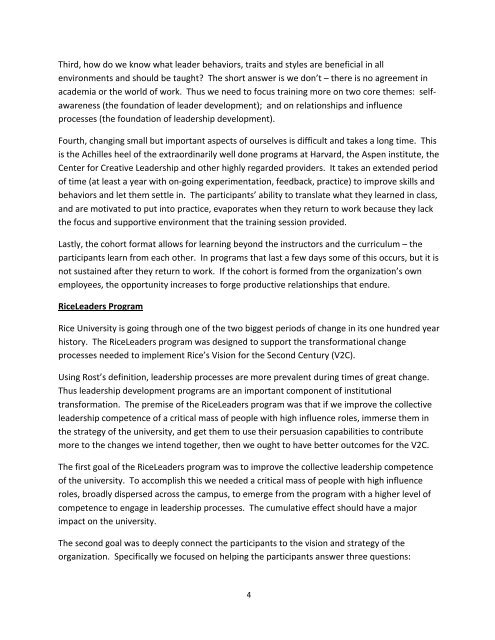Leadership Development in Support of Organizational Transformation
Leadership Development in Support of Organizational Transformation
Leadership Development in Support of Organizational Transformation
You also want an ePaper? Increase the reach of your titles
YUMPU automatically turns print PDFs into web optimized ePapers that Google loves.
Third, how do we know what leader behaviors, traits and styles are beneficial <strong>in</strong> all <br />
environments and should be taught? The short answer is we don’t – there is no agreement <strong>in</strong> <br />
academia or the world <strong>of</strong> work. Thus we need to focus tra<strong>in</strong><strong>in</strong>g more on two core themes: self-awareness<br />
(the foundation <strong>of</strong> leader development); and on relationships and <strong>in</strong>fluence <br />
processes (the foundation <strong>of</strong> leadership development). <br />
Fourth, chang<strong>in</strong>g small but important aspects <strong>of</strong> ourselves is difficult and takes a long time. This <br />
is the Achilles heel <strong>of</strong> the extraord<strong>in</strong>arily well done programs at Harvard, the Aspen <strong>in</strong>stitute, the <br />
Center for Creative <strong>Leadership</strong> and other highly regarded providers. It takes an extended period <br />
<strong>of</strong> time (at least a year with on-‐go<strong>in</strong>g experimentation, feedback, practice) to improve skills and <br />
behaviors and let them settle <strong>in</strong>. The participants’ ability to translate what they learned <strong>in</strong> class, <br />
and are motivated to put <strong>in</strong>to practice, evaporates when they return to work because they lack <br />
the focus and supportive environment that the tra<strong>in</strong><strong>in</strong>g session provided. <br />
Lastly, the cohort format allows for learn<strong>in</strong>g beyond the <strong>in</strong>structors and the curriculum – the <br />
participants learn from each other. In programs that last a few days some <strong>of</strong> this occurs, but it is <br />
not susta<strong>in</strong>ed after they return to work. If the cohort is formed from the organization’s own <br />
employees, the opportunity <strong>in</strong>creases to forge productive relationships that endure. <br />
RiceLeaders Program <br />
Rice University is go<strong>in</strong>g through one <strong>of</strong> the two biggest periods <strong>of</strong> change <strong>in</strong> its one hundred year <br />
history. The RiceLeaders program was designed to support the transformational change <br />
processes needed to implement Rice’s Vision for the Second Century (V2C). <br />
Us<strong>in</strong>g Rost’s def<strong>in</strong>ition, leadership processes are more prevalent dur<strong>in</strong>g times <strong>of</strong> great change. <br />
Thus leadership development programs are an important component <strong>of</strong> <strong>in</strong>stitutional <br />
transformation. The premise <strong>of</strong> the RiceLeaders program was that if we improve the collective <br />
leadership competence <strong>of</strong> a critical mass <strong>of</strong> people with high <strong>in</strong>fluence roles, immerse them <strong>in</strong> <br />
the strategy <strong>of</strong> the university, and get them to use their persuasion capabilities to contribute <br />
more to the changes we <strong>in</strong>tend together, then we ought to have better outcomes for the V2C. <br />
The first goal <strong>of</strong> the RiceLeaders program was to improve the collective leadership competence <br />
<strong>of</strong> the university. To accomplish this we needed a critical mass <strong>of</strong> people with high <strong>in</strong>fluence <br />
roles, broadly dispersed across the campus, to emerge from the program with a higher level <strong>of</strong> <br />
competence to engage <strong>in</strong> leadership processes. The cumulative effect should have a major <br />
impact on the university. <br />
The second goal was to deeply connect the participants to the vision and strategy <strong>of</strong> the <br />
organization. Specifically we focused on help<strong>in</strong>g the participants answer three questions: <br />
4


